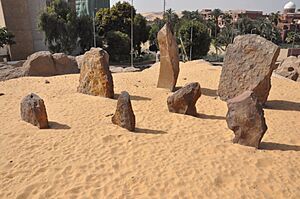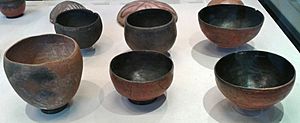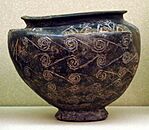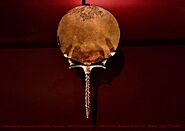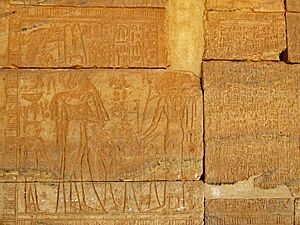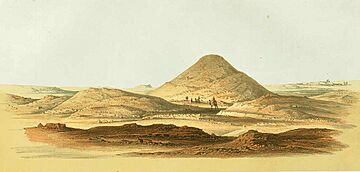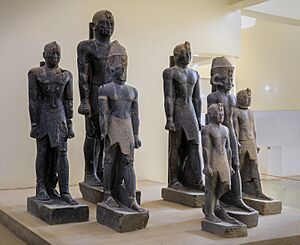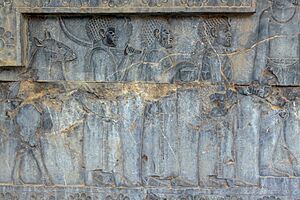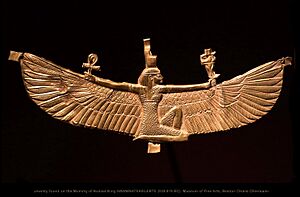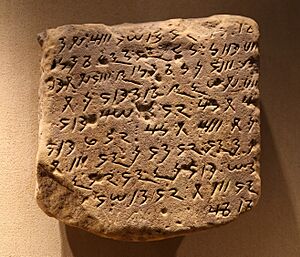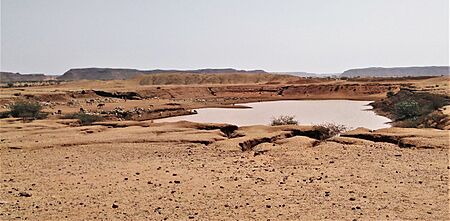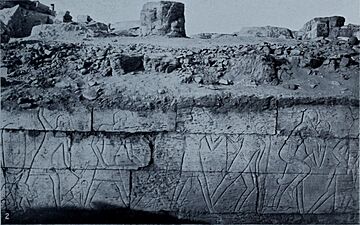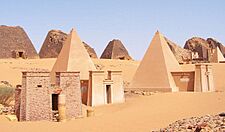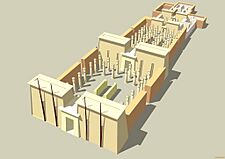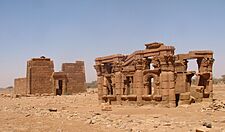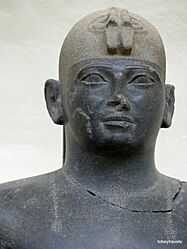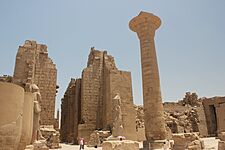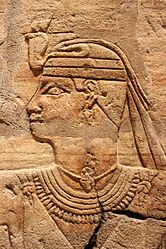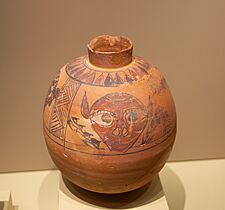Kingdom of Kush facts for kids
Quick facts for kids
Kingdom of Kush
Qes (Meroitic)
|
|||||||||||||||||
|---|---|---|---|---|---|---|---|---|---|---|---|---|---|---|---|---|---|
| c. 780 BC – c. 350 AD | |||||||||||||||||

Kushite heartland, and Kushite Empire of the Twenty-fifth Dynasty of Egypt, c. 700 BC
|
|||||||||||||||||
| Status | Independent (780 BC – 330 AD) Under Aksumite rule (330 AD – 350 AD) |
||||||||||||||||
| Capital | Kerma Napata Meroë |
||||||||||||||||
| Common languages | Meroitic Egyptian Blemmyan Old Nubian |
||||||||||||||||
| Religion | Kushite religion Ancient Egyptian religion |
||||||||||||||||
| Demonym(s) | Kushite | ||||||||||||||||
| Government | Monarchy | ||||||||||||||||
| Monarch | |||||||||||||||||
| Historical era | Bronze Age to Late Antiquity | ||||||||||||||||
|
• Established
|
c. 780 BC | ||||||||||||||||
|
• Capital moved to Meroe
|
591 BC | ||||||||||||||||
|
• Axumite capture of Meroë
|
330 | ||||||||||||||||
|
• Disestablished
|
c. 350 AD | ||||||||||||||||
| Population | |||||||||||||||||
|
• Meroite phase
|
1,150,000 | ||||||||||||||||
|
|||||||||||||||||
| Today part of | Sudan Egypt |
||||||||||||||||
The Kingdom of Kush was an ancient kingdom located in Nubia. This region is now part of northern Sudan and southern Egypt. Kush was a powerful civilization that grew along the Nile Valley.
Nubia was a place where many early civilizations developed. These societies were skilled in trade and industry. The city-state of Kerma became very important between 2450 and 1450 BC. It controlled a large area along the Nile River. The Egyptians called Kerma "Kush," and over time, the two civilizations often traded, fought, and shared ideas.
Later, much of Nubia came under the rule of ancient Egypt (1550–1070 BC). After Egypt's power weakened, the Kushites formed their own kingdom again in Napata. Even though Kush shared some culture with Egypt, like worshipping the god Amun, the Kushite people had their own unique language and way of life.
Around 750 BC, Kushite kings began to rule parts of Egypt. King Kashta became ruler of Upper Egypt, and his successor Piye conquered Lower Egypt. This started the Twenty-fifth Dynasty, where Kushite pharaohs ruled all of Egypt for about a century. However, the Assyrians eventually defeated the Kushites in the mid-seventh century BC. After this, the Kushite capital moved to Meroë. The Greeks called this kingdom "Aethiopia."
The Kingdom of Kush remained a strong regional power until the 4th century AD. It eventually weakened due to climate changes, internal conflicts, and invasions. The Aksumites from the south captured Meroë, and new groups like the Noba people emerged. This led to the end of the Kushite kingdom and the rise of new kingdoms in Nubia.
Recent discoveries show that Kush was a very advanced civilization. The Kushites had their own language and writing system. They had a complex economy based on trade and making goods. They were also excellent archers and had a well-organized society, where women played important roles.
Contents
- What is the Name of Kush?
- The History of Kush
- Language and Writing in Kush
- Kushite Innovations: Technology, Medicine, and Math
- The Kushite Military
- Architecture in Kush
- Economy of Kush
- Gallery
- See Also
What is the Name of Kush?
| Kush in hieroglyphs | |||||
|---|---|---|---|---|---|
k3š Ku'sh |
|||||
The name Kush was written in ancient Egyptian as kꜣš. This name likely came from a local word for the people who lived there. It also referred to the region south of the first major waterfall (cataract) on the Nile River.
Some ancient writings, like the Hebrew Bible, connect the name Kush to a person named Cush, who was a son of Ham. In Greek writings, Kush was known as Kous or Aethiopia.
The History of Kush
Early Civilizations in Nubia
Nabta Playa: An Ancient Observatory
Around 7500 BC, the Nabta Playa civilization appeared in Nubia. People here built large stone structures called megaliths. These might be some of the world's first astronomical devices, even older than Stonehenge! These early people lived in well-planned villages with deep wells that held water all year.
A-Group Culture: Early Nubian Life
The A-Group was an early civilization in Nubia that thrived around 4000 BC. It reached its peak around 3100 BC before declining. This culture created beautiful pottery and lived in areas like Aswan and Buhen.
Kerma Culture: A Powerful Kingdom
The Kerma culture was a major civilization centered in Kerma, Sudan. It flourished from about 2500 BC to 1500 BC. This kingdom grew very large and powerful, even rivaling Egypt at its strongest point.
Egyptian Rule in Nubia

Around 1504 BC, Egypt conquered Nubia, and it became an Egyptian colony. The Egyptians ruled Kush for several centuries, but the Kushites often rebelled. Nubia became very important to Egypt for its resources and trade. It was governed by an Egyptian official called the Viceroy of Kush.
The Rise of Independent Kush
After Egypt's power faded around 1070 BC, Kush became an independent kingdom once more. Its new center was Napata in modern Sudan. The first known Kushite king was Alara, who ruled between 800 and 760 BC. He is remembered as the founder of the dynasty.
Kushite Pharaohs Rule Egypt
Around 754 BC, Kushite kings began to expand their control north into Egypt. King Kashta peacefully became King of Upper Egypt. His successor, Piye, then conquered Lower Egypt. This established the Twenty-fifth Dynasty, with Kushite pharaohs ruling over both Kush and Egypt. They built and restored many temples and monuments, bringing a new period of prosperity to Egyptian culture.
The Assyrians Take Over Egypt

The Kushite pharaohs, like Taharqa, faced a powerful new enemy: the Assyrians. After some battles, the Assyrians invaded Egypt in 671 BC. Taharqa fled back to Nubia. His successor, Tantamani, tried to regain control of Egypt but was defeated. The Assyrians sacked the city of Thebes, and the Kushites were driven out of Egypt for good around 656 BC.
The Napatan Period
After losing Egypt, the Kushite civilization continued to thrive for centuries. Their capital remained at Napata. During this time, they interacted with the Persian Empire, which also claimed control over parts of their territory. Kushite kings revitalized old traditions, building royal statues and enlarging pyramids.
The Meroitic Period
Around 591 BC, the capital of Kush moved south to Meroë. This new location was rich in iron ore and wood, which was important for making iron tools. Meroë also had good access to trade routes. The Kushites traded iron goods, gold, ivory, and enslaved people with the Romans.
The Kushites also had conflicts with the Ptolemies (Greek rulers of Egypt) and later the Romans. A famous Kushite queen, Amanirenas, led her armies against the Romans in the 1st century BC. She even managed to defeat them in some battles and sacked Aswan. A bronze head of the Roman Emperor Augustus was found buried in Meroë, possibly taken as a trophy. Eventually, a peace treaty was signed, and trade between Kush and Roman Egypt increased.
Decline and Fall of Kush

By the 1st or 2nd century AD, the Kingdom of Kush began to weaken. This was due to wars, changes in climate, and internal rebellions. The Noba people, who lived west of the Nile, started to attack Kushite towns. Around 330 AD, the Aksumites from the south invaded and captured Meroë.
These events led to the end of the Kushite kingdom around the mid-4th century AD. After Kush fell, new kingdoms like Nobatia, Makuria, and Alodia emerged in Nubia. These kingdoms later converted to Christianity.
Language and Writing in Kush
The Meroitic language was spoken in Kush during the Meroitic period. It died out around 400 AD. We are still learning about this language, and it's not clear if it's related to Egyptian or other African languages.
In the early Napatan period, Kushites used Egyptian hieroglyphs. Later, they developed their own unique writing system called the Meroitic alphabet. It had two forms: Meroitic Cursive for everyday records and Meroitic Hieroglyphic for important royal or religious documents. This script was deciphered, but the language itself is still largely a mystery to modern scholars.
Kushite Innovations: Technology, Medicine, and Math
Technology in Kush
The Kushites developed a type of water wheel called the saqiyah to improve irrigation. This machine used animals to lift water, making farming much easier than before. The ancestors of the Kushites, the Kerma culture, were also skilled in making bronze objects like razors and mirrors.
During the Meroitic period, Kushites built large reservoirs called hafirs. These collected rainwater during the wet season to provide water for people, crops, and animals during dry times. The "Great Hafir" at Musawwarat es-Sufra is a famous example. The Kushites were also experts in iron working, using furnaces to produce metal tools and weapons.
Medicine in Kush
Studies of ancient Nubian mummies in the 1990s showed that Kushites were using early forms of antibiotics. Scientists found traces of tetracycline in bones from 350 AD to 550 AD. It's thought that a bacterium in the grain used for making beer produced this antibiotic. People might have noticed that drinking beer helped them stay healthier.
Mathematics in Kush
The Kushites had a good understanding of mathematics. Engraved plans of King Amanikhabali's pyramids show they understood complex ratios. They also created a system of geometry and used early versions of sun clocks. During the Meroitic period, they used trigonometric methods similar to the Egyptians.
The Kushite Military
Kushite armies were famous for their skilled bowmen. Ancient sources say these archers used long, powerful bows. Their arrows were sometimes tipped with poison.
During sieges, the Kushites used advanced tactics. King Piye's army built siege towers to help archers fire down into enemy cities. They also used battering rams to break through city walls. In later periods, elephants were occasionally used in battles, for example, against the Romans.
Architecture in Kush
Kushite architecture was impressive. They built unique tomb monuments, which evolved from earlier Nubian burial styles. The tombs became larger over time, with some carved into solid rock.
The Kushites also built pyramids, especially at sites like el-Kurru, Nuri, Jebel Barkal, and Meroë. These pyramids are smaller and have steeper sides than the famous Egyptian pyramids. They also constructed mud-brick temples and grand masonry temples, often borrowing ideas from Egyptian temple designs. The Nubian vault was another architectural innovation from Kush.
Kushite homes were often circular timber huts, but they also built apartment houses for larger families. They constructed stone-paved roads, piers along the Nile, and many wells.
Economy of Kush
The economy of the Kingdom of Kush likely involved a system where the state collected extra goods (like crops) as taxes. These goods were then shared among the people. Many people in Kush worked on the land, producing food and other necessities. The northern parts of Kush seemed to be wealthier and more productive than the southern areas.
Gallery
-
The pyramids of Meroe – UNESCO World Heritage
-
Amun temple of Jebel Barkal, originally built during the Egyptian New Kingdom but greatly enhanced by Piye
-
Portrait of Taharqa, Kerma Museum
-
Taharqa's kiosk, Karnak Temple
See Also
 In Spanish: Reino de Kush para niños
In Spanish: Reino de Kush para niños
- Aethiopia is an ancient Greek geographical term which referred to the regions of Sudan and areas south of the Sahara desert.
- List of monarchs of Kush
- Merowe Dam
- Nubiology
- Twenty-fifth Dynasty of Egypt family tree


